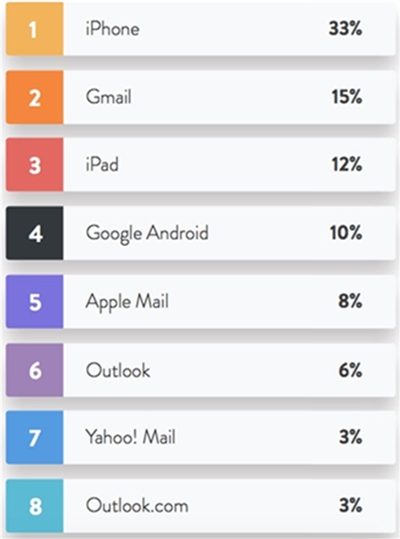Clearly, as a business owner or marketer, you understand the importance of email marketing. But are you doing it right?
Here are eight ways you may be sabotaging your email marketing efforts—and what you should be doing instead.
1.You dangle your lead magnet in front of the entire world
You're on a lead magnet promotion spree. Facebook groups, LinkedIn Groups, forums... You use every possible marketing avenue. And it seems to be working, because your list is growing as if on steroids.
Promoting your lead magnet is necessary, but have you ever thought about the quality of the list you're building? Are all those new subscribers your target audience? Are they genuinely interested in your products and services, or are they just in for that free PDF?
List quality is the most important goal of email marketers (70% of them say so), and 39% say poor email subscriber quality as a significant barrier to the success of an email list strategy, according to an email list strategy survey by Ascend2.
It doesn't matter how big your list is. If your list isn't made up of your target audience and active subscribers, they aren't going to buy from you or care about your products.
2. You disappear once they take the bait
Opt-in > Welcome Email
Apart from the above sequence, you don't use an autoresponder series—a series of pre-written emails that are sent to your subscribers in a sequence.
Among the benefits of autoresponder emails is that you...
- Control what information your subscriber receives and in what order
- Reintroduce old content to new subscribers
- Introduce your affiliate products and paid offerings in a noninvasive way and provide value at the same time
- Save time nurturing leads by automating the onboarding process
Consistent, high-value communication with your list is critical to building a relationship with your prospects and customers. Autoresponder emails work very well to automate the process.
3. You waste your welcome email with a generic 'Thank you for subscribing'
Welcome emails have the highest open rates (50-60%) among marketing messages. Subscribers are most engaged when they first sign up for your list. They look forward to receiving the value you'll provide. But they may also be unsure whether you can deliver on your promise.
The experience a subscriber has with your emails in the first couple of weeks will set the tone for the rest of their time on your list. You'll be squandering the opportunity to wow them and gain their trust if you send only a "Thank you for subscribing" email.
Here are some ideas for what you should be sending in your welcome emails:
- Tell them about your "why" for starting your business and your brand story.
- Encourage them to follow you on other social media networks.
- Direct them to your top content and resources.
- Set subscribers' expectations right from the start. Let them know how frequent your emails will be and when they can expect to hear from you.
- Have a product- or service-based business? How about sending them a trial or discount code?
- Remind them to white-list your emails.
4. You don't segment your list
You haven't the faintest clue about the varying interests and needs of the various segments of your list. But, just as it is important to have products of different price offerings, it is important to segment your list based on their needs and interests, because then you'll be able to send targeted offers that are of relevance and value to those subscriber segments.
Marketers who segmented their email list experienced higher open rates and lower unsubscribe rates, according to Mailigen:
- 39% increase in open rates
- 34% greater email relevance
- 28% lower unsubscribe rates
Most email marketing service providers enable a simple subscriber tag or list segment feature based on your subscribers' link clicking behavior or lead magnet opt-in choices.
5. You send only broadcast emails
Broadcast emails are one-time emails sent to all of your subscribers. Most broadcast emails are blog post notifications and promotional emails. They are an important part of the email marketing mix, but they shouldn't be the only type you send your list.
Broadcast emails have a lower click-through rate than segmented emails, because their content is not equally relevant to all your subscribers.
6. Your emails are complicated
Stop distracting your subscribers with several calls to action. Do you want them to click over to your blog article or sales page? Pick the most important call to action—the single step that you want them to take.
Strip your emails off unnecessary sidebars, and graphics. Your subscribers will be more likely to perform that single call to action if they don't have to fight all those unnecessary distractions.
7. Your emails are not mobile-optimized
Some 33% of email opens occur on an iPhone, while Gmail accounted for 15% of opens, according to Litmus:

And according to Constant Contact, "75% of Americans will simply delete an email before reading it if it is not optimized to be viewed on their screens" (as reported by marketing agency Brafton).
So, if your email is not mobile-optimized for easy reading and interaction, you'll be missing out on increased conversions and higher click-through rates.
8. You don't re-engage 'dead' email subscribers
If they haven't responded, opened, clicked, or otherwise interacted with your emails in any way in 6-12 months, they are inactive subscribers—and huge missed opportunity for engagement and revenue.
But it's often easier to re-engage "dead" subscribers than to capture new ones. Have a process in place to sieve out inactive subscribers. Send them specific win-back or re-permission emails.
Explain your interest in reviving the relationship. Tell them exactly what they can do to display their interest. If they don't respond positively, remove them from your list. Doing so will save you time, energy and cost in the long run.




